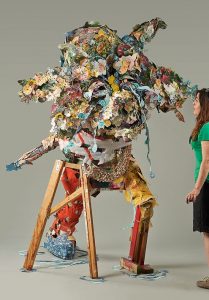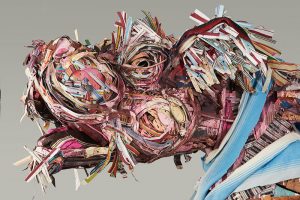Meet the artist and share her vision
At a recent guild-sponsored lecture at Contemporary Craft, featured Bridge 13 artist Elisabeth Higgins O’Connor talked about the evolution of her style and body of work. Guild secretary Wanda Spangler-Warren took her usual meticulous notes and lent them to us for this post. Thanks, Wanda!
The huge, grotesquely charming, animal-ish forms lumbering around SCC’s gallery owe their existence to a series of happy accidents involving drywall screws, the Iraq war, and a truckload of discarded cushions. Which is just another way of saying O’Connor never met a random input she couldn’t use.

As a resident artist in Kohler’s Arts/industry Program, O’Connor learned the slip casting method of making vitreous china, a technique she would later intentionally corrupt by using found objects, creating animal hybrids with ceramic heads and fabric bodies. Perhaps more importantly, Kohler made available to her a huge inventory of hardware – screws, wires, and grommets – which she used to assemble her figures in obvious and deliberate ways.
Moving even further away from the “preciousness” and tight rendering of fired clay, O’Connor began to source thrift shop materials such as afghans, rugs, and bedspreads, which she dipped into cement and glue before wrestling the heavy, dripping mass into place. She loved the inherent crudeness of these materials, the way they defied refinement and insisted on revealing their color and tactility.
Knowing that O’Connor was always on the lookout for interesting materials, a friend who managed a thrift store dumped a truckload of rejected sofa cushions in her studio driveway. It proved to be an auspicious gift. O’Connor drew upon her background in clay to work with these slabs of foam and upholstery. She abandoned the messy cement dip and began to create armatures out of 2 x 4s, roping and stitching heads over the top of the armatures and embroidering the facial features.

Most recently, O’Connor has begun constructing the heads of her figures from cardboard forms, encased in bedspread strips and dipped into matte medium. This new construction technique has made possible even larger sculptures than the ones on display here, currently up to 12 feet high.
In the question and answer session that followed the lecture, O’Connor said she chooses to work with household materials, especially bedding, “because of the poetic concepts of dreams, nightmares, night sweats, birth, illness, and death. There is poetic imagery in this material. That’s why I insist on having my work described with the words bedding, bed sheets, afghans, etc. – to invoke that imagery. It’s not ‘mixed media.’”

Perhaps because of her closeness to the sculptures, O’Connor resisted categorizing them in any narrative way. She will not say if a given piece speaks of joy, pain, fear, or triumph. “Do I laugh or weep?” she asks. “If the piece is successful, I do both.”
I doubt the viewer will be able to keep such a comfortable distance. These ungainly figures, so hobbled by the weight of bad circumstances and bad choices, nonetheless flaunt their tattered finery and clamor to tell their stories. They implore us, flirt with us, and demand that we grant them dignity. The show runs through August 22 at Contemporary Craft, 2100 Smallman Street, Pittsburgh. Leave a comment below and tell us what you think!
